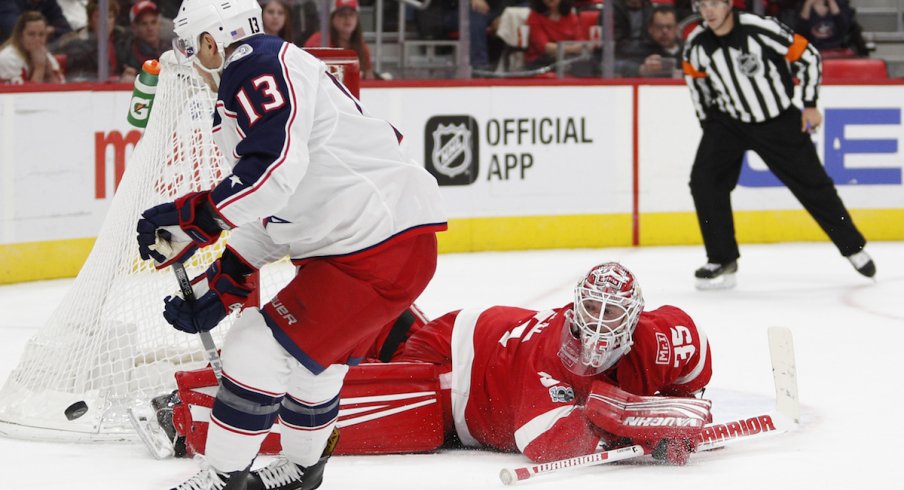The Blue Jackets are providing no shortage of things to talk about this year.
When it comes to looking at tools they have to win games, there’s one area of play that perhaps we should be focusing on more, for a team that has to exploit every possible margin it can: the penalty kill.
Columbus’ aggressive penalty kill drew attention three years ago for its “power killing” tendencies – meaning that it was focused on creating offensive opportunity and not just preventing opponents’ power plays from scoring. That offensive edge slowed a bit last season when the team was without key penalty killers such as Cam Atkinson and Josh Anderson due to prolonged injuries. This season, with the departure of Anderson and another core power killer, Alexander Wennberg, it was fair to wonder which penalty kill we would see from Columbus this season.
But as far as the coaching staff is concerned, the power kill remains part of the team’s identity.
“Yeah, we are (trying to encourage (that aggressive offensive play),” head coach John Tortorella said. “(We have a) lot of new faces, there is a lot of teaching going on with it. “in every one of the meetings that (assistant coach Brad) Shaw has he’s always pushing them to get up the ice with it ,and if there’s an opportunity with so many teams playing with four – and sometimes five – forwards (on the power play), we want to be testing them that way when we have an opportunity. So the aggression, the attitude is still there.”
There are signs this season’s penalty kill may be returning to true power kill form, and you need look no further than Atkinson’s shorthanded breakaway turned penalty shot that resulted in a goal in Monday’s game against Carolina.
In this clip we see the hallmarks of a power kill from the Blue Jackets: first, the deployment of a top offensive forward in Atkinson; second, the aggressive forward play out of the two-time All-Star in the wedge-plus-one formation that doesn’t just prevent the Hurricane’s pass, but goes one step further to turn a broken play into a scoring chance.
“They had a one-timer up top,” Atkinson said post-game. “I knew that’s what they wanted, I anticipated that and I think I was the one that made the play. I had a step (and drew the penalty shot).”
The result was the second short-handed goal of the season for Atkinson and the 14th of his career, tying him with Rick Nash for the most short-handed goals by a Blue Jacket in franchise history.
“Cam has some of the best anticipation skills as a penalty killer,” Tortorella said. “I think him playing on the power play helps him because I think he can almost see where the next play can be, or (he) anticipates that play. I think his quickness comes into play.”
And while every penalty kill can’t result in a goal, there are signs in the unit’s underlying play that the offensive edge is truly back. Last season, according to evolving-hockey.com, the Blue Jackets ranked 20th among all NHL teams in offensive creation when playing a man down (.86 expected goals / 60), but early in this season, they rank third in the same measure with 1.28 expected goals per 60 minutes of play.
Power kIll
Of course, while this offensive creation is a great sign, there is still work to do on the penalty kill. Just as with five-on-five play, the Blue Jackets’ short-handed crew has stumbled a bit defensively. After ranking third best last season in terms of preventing offense against (5.82 expected goals against /60), they currently sit 20th overall with 6.64 expected goals against per 60. After being perfect on the penalty kill in seven of their first 10 games, Columbus has allowed five power play goals against across 15 penalty kills in their last six contests.
“it started off pretty well, it’s been a struggle of late,” Tortorella said. “If (opponents) don’t score goals, we’ve still given up quite a few chances, so we’re going to continue working at it.”
As with so many things, there is always work to do, but the good news is that as the Blue Jackets penalty kill seeks to solidify itself defensively, the team is retaining its overall discipline ranking second in the NHL in total penalty kill minutes – it ended last season ranked sixth overall. So, if the Blue Jackets can find more defensive effort in their game, keeping the power kill as part of their identity may be a welcome source of offense – and perhaps even goals – in a season where every puck in the net matters.
All data via evolving-hockey.com and represents shorthanded play.
